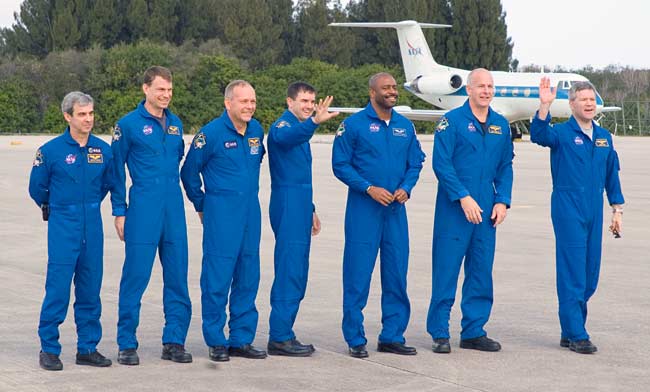'Dicey' Forecast Lingers for Shuttle Launch

CAPECANAVERAL, Fla. ? A poor weather forecast continues to threaten a Thursdaylaunch attempt of the space shuttle Atlantis, but NASA mission managers haven'tthrown in the towel yet.
Monday's launch-dayforecast here at Kennedy Space Center (KSC) called for worrisome rain andlow-ceiling clouds on Feb. 7. Now thick anvil clouds that might produce thunderstorms are expected around the 2:45 p.m.EST (1945 GMT) launch time.
"Today'sgoing to be our last day of sunny, hot weather in central Florida," said MikeMcAleenan, a NASA launch weather officer. He explained that a massive coldfront is propelling the problematic conditions toward Atlantis, whichnow sits at launch Pad 39A. "That's going to be ? causing some diceyweather for area Thursday."
Despite thethreat of thunderstorms, however, McAleenan said there's still a 40 percentchance that Atlantis will make a space shot on Thursday ? the same predictionweather officers offered on Monday.
"Thelaunch time makes a difference," he said, noting that a launch attempt laterin the day (when thunderstorms often peak) would have a considerably reducedchance of passing NASA's flight rules.
Rain duringa launch can damage the heat-resistant tiles beneath Atlantis as it rocketsinto orbit, while a stray bolt of lightning could have explosive consequencesafter the spaceship leaves the lightning protection system of the launch pad. BillJohnson, a NASA spokesperson at KSC, said mission managers will postpone alaunch if there's any lightning within an 11.5-mile (18.5-km) radius of the shuttleshortly before launch.
NASA testdirector Steve Payne said the agency will wait to seriously discuss a launchdelay until early Thursday morning, when filling of Atlantis' 500,000-gallon(1.9 million-liter) externalfuel tank is set to begin.
Breaking space news, the latest updates on rocket launches, skywatching events and more!
"If wetank we're going to make a run at [launch], if we don't tank we're going tohold off and see if the weather improves," Payne told SPACE.com.
Aside fromKSC, weather conditions at emergency landing sites in the U.S., France and Spain violate none of NASA's stringent flight rules. Should a hole in the cloudsnot open up for launch on Thursday, mission managers will try again at around2:20 p.m. EST (1920 GMT) on Friday Feb. 8.
The sevenastronauts of Atlantis, in the meantime, have undergone medical exams andflown training flights in NASA T-38 jets in preparation for their 11-day mission to theInternational Space Station (ISS).
NASA'sprime goal with the crew's STS-122 mission is to deliver the long-awaited Columbus module, a cylindrical room that weighs about 10.3 tons and houses 10phone-booth-sized racks, to the ISS.
CommanderStephen Frick will lead the mission and will be accompanied by pilot AlanPoindexter, mission specialists Leland Melvin, Rex Walheim and Stanley Love. EuropeanSpace Agency astronauts Hans Schlegel and L?opold Eyharts also join the crew. Eyhartswill replace ISS Expedition 16 crew member Dan Tani, who will return to Earthin mid-February with the STS-122 astronauts.
NASAwill broadcast Atlantis' STS-122 mission live on NASA TV. Click here for SPACE.com'sSTS-122 mission coverage and NASA TV feed.
- SPACE.com Video Interplayer: NASA's STS-122: Columbus Sets Sail for ISS
- The Great Space Quiz: Space Shuttle Countdown
- VIDEO: ISS Commander Peggy Whitson Takes Charge
Dave Mosher is currently a public relations executive at AST SpaceMobile, which aims to bring mobile broadband internet access to the half of humanity that currently lacks it. Before joining AST SpaceMobile, he was a senior correspondent at Insider and the online director at Popular Science. He has written for several news outlets in addition to Live Science and Space.com, including: Wired.com, National Geographic News, Scientific American, Simons Foundation and Discover Magazine.
